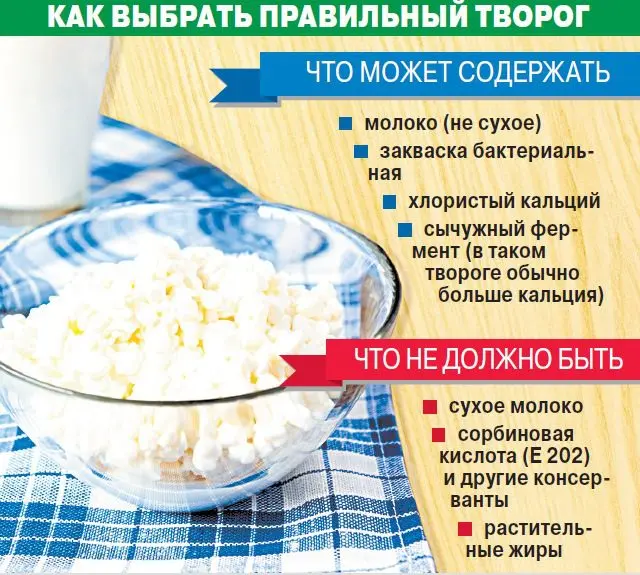
How to choose the right cottage cheese?
Cottage cheese is divided into several categories, for each of which there are certain characteristics. It is difficult to name a specific product the most delicious due to the different taste preferences of buyers. Some like crumbly and sour cottage cheese more, others like a product with small grains combined into a homogeneous thick mass.
Traditional classification of curd:
- classic, fatty, low-fat and low-fat (according to the degree of fat content);
- grainy and homogeneous (in consistency);
- separate and traditional (according to the manufacturing method).
For buyers, the classification of cottage cheese by fat content and consistency plays an important role, but the method of manufacturing the product should also be paid attention to so that the expectations from its purchase are justified. The traditional method of making curd is based on milk fermentation, and with the separate method, the main ingredient is first separated into cream and skim milk and only after that the fermentation process begins. In the first case, crumbly cottage cheese is obtained, in the second, the product acquires an oily and almost uniform consistency. In terms of taste, both varieties have their own differences.
What cottage cheese is suitable for what:
- for baby food, the fat content of cottage cheese should not exceed 2%;
- during pregnancy and breastfeeding, it is not recommended to buy cottage cheese above 9% fat;
- 18% and 22% are the most common types of cottage cheese that most fans of this product consume;
- cottage cheese with a fat content of more than 23% is most often purchased for the preparation of various dishes.
How to identify good curd
When choosing cottage cheese, you first need to pay attention to its variety in terms of fat content, consistency and manufacturing method. This information will help you get an impression of the product in advance and predict its taste. After studying such data, the curd must be evaluated visually.

Signs of good cottage cheese:
- grainy consistency, milky white tint and tenderness of the mass indicate that the product is made from natural milk, it will have a creamy taste;
- when rubbed between fingers, high-quality cottage cheese will change its structure and leave an oily mark on the skin;
- it is better to buy cottage cheese in transparent packages so that you can evaluate it visually;
- the packaging of the curd should not be damaged;
- you need to buy the freshest cottage cheese by the date of manufacture;
- the consistency of the curd should be slightly crumbly, if the product is too homogeneous, then palm oil was used to make it;
- real cottage cheese always smells like milk or yeast;
- the taste of high-quality cottage cheese cannot be called sour or sweet, and the sour taste should be insignificant.
The taste of cottage cheese directly depends on its fat content: the lower the percentage of fat, the less pronounced the taste will be. This nuance must be taken into account before purchasing a product. If cottage cheese is bought by weight, then its visual assessment must be carried out especially carefully. The product should be rubbed through your fingers, sniffed and, if possible, immediately tasted.
Signs of low-quality cottage cheese:
- a pronounced granular consistency is not always a sign of the quality of cottage cheese, if the grains are too hard and give the impression of dry particles, then the product is overcooked and will taste bitter;
- the bitter taste of cottage cheese indicates a violation of the process of its manufacture or storage;
- when rubbed with your fingers, low-quality cottage cheese will retain its structure, and the oily substance will not be released from it;
- damage to the packaging should be the reason for refusing to buy the product;
- a swollen lid or packaging is a sign of spoiled cottage cheese;
- in no case should you buy cottage cheese with an expired shelf life or in the last days before the specified date;
- frozen cottage cheese completely loses its taste;
- – white, blue or greenish particles may be present in the curd mass, which indicates the beginning of the development of mold;
- the yellow color of the mass can only be in spoiled cottage cheese;
- good cottage cheese cannot be liquid;
- if the cottage cheese does not smell like milk, then you should refrain from buying it;
- if the color of the cottage cheese is not uniform, then this is a sign of mixing products of different quality (or fresh cottage cheese with spoiled one);
- if the packaging contains too many additional ingredients with unfamiliar names, then such a product is not worth buying (real cottage cheese should contain only natural ingredients);
- too low price of cottage cheese is the first sign of substitution of product components for soy, vegetable fats and other cheap ingredients.
Manufacturers often add starch to the curd. This is done with one goal – to increase the mass of the final product. It is quite difficult to determine the presence of an additional component visually, but at home this is done with the help of iodine. A blue drop of a substance on the surface of the curd is a sign of the presence of starch.









